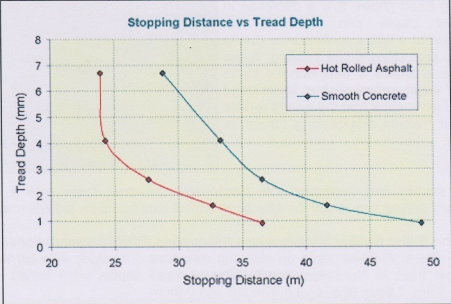Tyre Tread Depth and Stopping Distances
Background
It has long been known that a decrease in tyre tread depth can lead to the deterioration of a tyre's performance during cornering, and straight line braking in the wet. A tyre is unable to deal ith the same volume of water on the road at lower tread depths, which means that the tyre is unable to transmit traction and braking forces as effectively.Previous studies had confirmed this relationship, however there was a need for independent testing to quantify the effects on typical cars found on today's roads.
In 2003, the British Rubber Manufacturers Association (BRMA) commissioned MIRA to study the effects of tread depth on stopping distances. The study was carried out on MIRA's test track in Nuneaton, and 5 different tread depths were tested - 6.7mm, 4.1mm, 2.6mm, 1.6mm (the legal minimum) and 0.9mm.
Vehicles were mounted with equipment to record time, speed, and distance. The tests were carried out on two different surfaces at the testing track, hot rolled asphalt and smooth concrete. In order to ensure the accuracy of the results, the tests were repeated several times.
The stopping distance was recorded at each of these tread depths and the points plotted on a graph of stopping distance versus tread depth. A line was drawn through the points to show the trend between stopping distance and tread depth, from which information could be taken.
Results
The test results are displayed in the graph below. The stopping distance is different for the two road surfaces due to their different water retention properties.
Stopping Distance vs Tread Depth

From the graph of results, it can be seen that the stopping distances start to increase dramatically at tread depths of below 3mm.
At the legal minimum tread depth of 1.6mm, the stopping distance is increased by 36.8% on the hot rolled asphalt and 44.6% on the smooth concrete.
Recommendations
From the independent research, RoSPA recommends that tyres are changed once the tread reaches 3mm in depth.
Tyre pressure also affects a vehicle's safety by reducing its handling capability. If a tyre is over or under inflated, less rubber will be in contact with the road which leads to increased tread wear, and may increase the vehicles stopping distance. It is recommended that you check all of your tyre pressures regularly, as well as inspecting the tyre for damage.
More information about how to ensure your tyres are safe, you can visit RoSPA's Tyre Information Fact Sheet.


 Spidersnet
Spidersnet